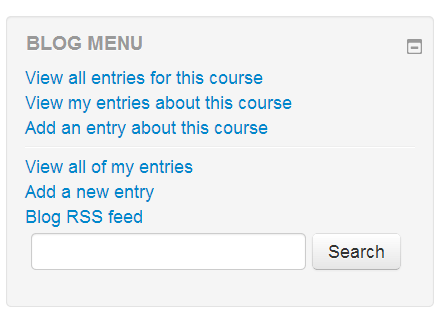Enabling / disabling blogs
Blogs in Moodle are enabled by default. They may be disabled by a site administrator in Administration > Site administration > Advanced features by setting the blog visibility to 'Disable blog system completely'.
My profile settings
Blog entries per page
In Administration > My profile > Blogs > Preferences you can set how many blog entries are displayed on a page. The default number of entries is 10.
Site administration settings
Blogs have additional settings which may be changed by an administrator in Administration > Site administration > Appearance > Blog.
Enable blog associations
If blog associations are enabled, users can blog about their course or a particular activity using the context-sensitive links for adding an entry in the Blog menu block e.g. 'Add an entry about this assignment' or 'Add an entry about this course'.
Two capabilities:
(both allowed for the default roles of authenticated user and student) enable blog associations to be restricted to particular courses and/or activity modules (in Moodle 2.3.2 onwards).
Blog visibility
This setting allows you to restrict the level to which user blogs can be viewed on this site. Note that they specify the maximum context of the VIEWER not the poster or the types of blog posts. Blogs can also be disabled completely if you don't want them at all.
Note: Sites upgrading to 2.0 which previously had blog visibility set to "Users can only see blogs for people who share a course" or "Users can only see blogs for people who share a group" will have blogs converted into blog-like format forums.
Enable external blogs
Enables users to specify external blog feeds. Moodle regularly checks these blog feeds and copies new entries to the local blog of that user.
External blog cron schedule
How often Moodle checks the external blogs for new entries. By default it is 24 hours.
Maximum number of external blogs per user
By default, the number of external blogs each user is allowed to link to their Moodle blog is 1.
Enable comments
Blog comments are enabled by default, though may be disabled if required.
Blog capabilities
- Create new blog entries
- Edit and manage entries
- Edit and manage external blogs
- Search blog entries
- View blog entries
- View draft blog entries
- See all user blogs
- Associate blog entries with courses
- Associate blog entries with activity modules
The Blogger role may be used to limit blogging to specific users only.

